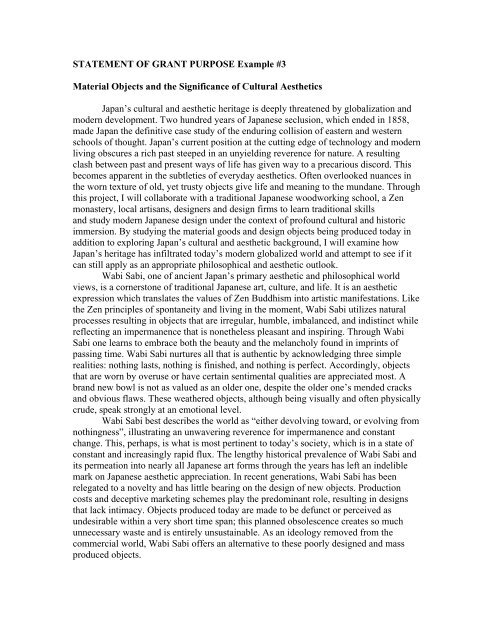STATEMENT OF GRANT PURPOSE Example #3 - risd/careers
STATEMENT OF GRANT PURPOSE Example #3 - risd/careers
STATEMENT OF GRANT PURPOSE Example #3 - risd/careers
You also want an ePaper? Increase the reach of your titles
YUMPU automatically turns print PDFs into web optimized ePapers that Google loves.
<strong>STATEMENT</strong> <strong>OF</strong> <strong>GRANT</strong> <strong>PURPOSE</strong> <strong>Example</strong> <strong>#3</strong><br />
Material Objects and the Significance of Cultural Aesthetics<br />
Japan’s cultural and aesthetic heritage is deeply threatened by globalization and<br />
modern development. Two hundred years of Japanese seclusion, which ended in 1858,<br />
made Japan the definitive case study of the enduring collision of eastern and western<br />
schools of thought. Japan’s current position at the cutting edge of technology and modern<br />
living obscures a rich past steeped in an unyielding reverence for nature. A resulting<br />
clash between past and present ways of life has given way to a precarious discord. This<br />
becomes apparent in the subtleties of everyday aesthetics. Often overlooked nuances in<br />
the worn texture of old, yet trusty objects give life and meaning to the mundane. Through<br />
this project, I will collaborate with a traditional Japanese woodworking school, a Zen<br />
monastery, local artisans, designers and design firms to learn traditional skills<br />
and study modern Japanese design under the context of profound cultural and historic<br />
immersion. By studying the material goods and design objects being produced today in<br />
addition to exploring Japan’s cultural and aesthetic background, I will examine how<br />
Japan’s heritage has infiltrated today’s modern globalized world and attempt to see if it<br />
can still apply as an appropriate philosophical and aesthetic outlook.<br />
Wabi Sabi, one of ancient Japan’s primary aesthetic and philosophical world<br />
views, is a cornerstone of traditional Japanese art, culture, and life. It is an aesthetic<br />
expression which translates the values of Zen Buddhism into artistic manifestations. Like<br />
the Zen principles of spontaneity and living in the moment, Wabi Sabi utilizes natural<br />
processes resulting in objects that are irregular, humble, imbalanced, and indistinct while<br />
reflecting an impermanence that is nonetheless pleasant and inspiring. Through Wabi<br />
Sabi one learns to embrace both the beauty and the melancholy found in imprints of<br />
passing time. Wabi Sabi nurtures all that is authentic by acknowledging three simple<br />
realities: nothing lasts, nothing is finished, and nothing is perfect. Accordingly, objects<br />
that are worn by overuse or have certain sentimental qualities are appreciated most. A<br />
brand new bowl is not as valued as an older one, despite the older one’s mended cracks<br />
and obvious flaws. These weathered objects, although being visually and often physically<br />
crude, speak strongly at an emotional level.<br />
Wabi Sabi best describes the world as “either devolving toward, or evolving from<br />
nothingness”, illustrating an unwavering reverence for impermanence and constant<br />
change. This, perhaps, is what is most pertinent to today’s society, which is in a state of<br />
constant and increasingly rapid flux. The lengthy historical prevalence of Wabi Sabi and<br />
its permeation into nearly all Japanese art forms through the years has left an indelible<br />
mark on Japanese aesthetic appreciation. In recent generations, Wabi Sabi has been<br />
relegated to a novelty and has little bearing on the design of new objects. Production<br />
costs and deceptive marketing schemes play the predominant role, resulting in designs<br />
that lack intimacy. Objects produced today are made to be defunct or perceived as<br />
undesirable within a very short time span; this planned obsolescence creates so much<br />
unnecessary waste and is entirely unsustainable. As an ideology removed from the<br />
commercial world, Wabi Sabi offers an alternative to these poorly designed and mass<br />
produced objects.
There exists little doubt over the gravity of the environmental crisis. I believe that<br />
in the near future, as companies are ever more pressured by consumer awareness and<br />
government intervention to make products sustainable, the main issue will be to find a<br />
way to seamlessly align the interests of business, product, and sustainability. My goal is<br />
to prove that Wabi Sabi ideals and their application in daily life can serve as a fitting<br />
solution to the ecological predicament. I will demonstrate this by implementing<br />
traditional Wabi Sabi principles into modern life via the creation of functional objects<br />
designed with a strict adherence to these precepts. Though it is impossible to design Wabi<br />
Sabi into something, as this is an essence derived through use, my line of objects will be<br />
designed with the capacity to become Wabi Sabi, predisposed to essential<br />
Wabi Sabi ideals. Through this fusion of old and new, the philosophical and the practical,<br />
I will take into account new materials that fit into Wabi Sabi ideology, as well as new<br />
processes, technologies, and applications to satisfy the needs of today’s consumers.<br />
Through my connection with Shinrin Takumi Juku, a renowned woodworking<br />
school in Takayama , as well as with local artisans and designers, I will design and<br />
fabricate functional objects that will not only pay homage to Japan’s history, but merge it<br />
together with modern needs, practices, and concepts to forge a working relationship for<br />
the future, ensuring Japan’s rich heritage is not lost, but fully embraced and appropriately<br />
integrated into today’s ever changing high tech society.<br />
At Shinrin Takumi Juku, I will engage in a rigorous traditional woodworking<br />
experience, learning new skills that will bolster my existing knowledge of woodworking.<br />
Approved by Osamu Shoji, the head professor of the school, I will enroll as a fulltime<br />
student during the upcoming school year. As the learning process revolves around<br />
demonstration and then implementation by students, any language barrier can be<br />
overcome; additionally, most professors can communicate effectively in English and<br />
there have been many successful English-only speaking interns in past years. My<br />
intention at Shinrin Takumi Juku is to learn a traditional skill set that will enable me to<br />
craft my line of objects in a culturally sensitive way, and to dynamically examine<br />
the aesthetic values of traditional Japanese woodworking. I will augment my year of<br />
academic study with frequent trips to Tokyo and Osaka to meet with practicing designers<br />
and design firms, and to grasp a divergent yet relevant point of view. Concurrently, I will<br />
have access to an extensive woodshop and will execute the tangible part of my project<br />
using the tools and machinery at my disposal.<br />
Prior to the start of the school year, I will spend a month living at Sogenji<br />
Monastery, a Rinzai Zen temple in Okayama, Japan. The Rinzai school of Zen is marked<br />
by the emphasis it places on “kensho”, seeing one's true nature through enlightenment, as<br />
well as the rigor and severity of its training methods. As I take part in serious monastic<br />
practice, I will experience firsthand the way of life most akin to Wabi Sabi. Since its<br />
inception as a distinct aesthetic mode, Wabi Sabi has been linked with Zen Buddhism as<br />
it embodies many of Zen’s core philosophical principles. My connection is Daichi, an<br />
English speaking nun at Sogenji, who is also an artist trained as a potter. I will utilize her<br />
connections to local potters and visit the workshops and studios of these traditional<br />
craftsmen, and to become acquainted with their artistic pursuits. I believe this experience<br />
will deeply affect my perception and understanding of a true Wabi Sabi lifestyle, as<br />
essentials are eliminated and I enter, even though for just a short while, a life not
equiring any money, training, knowledge, or special skills. I hope that by the end of this<br />
month, I will be open enough to understand unconventional beauty,<br />
willing to accept things as they naturally are, and be able to focus on appreciating rather<br />
than perfecting.<br />
Material Objects and the Significance of Cultural Aesthetics is a celebration of<br />
Japan’s cultural legacy. As a young designer fascinated and inspired by the uniqueness<br />
and relevance of cultural aesthetics, I am fearful that they are becoming lost amidst the<br />
cheapness and convenience of modern times. My investigation proposes ways of ensuring<br />
cultural survival and recognizes the profound solutions this facilitates to problems<br />
brought on by globalization and industrialization. This is a project of experience,<br />
understanding, expansion, and a passionate objective that would forever shape my view<br />
of the importance of objects and the role they play in a greater discourse of design.
















